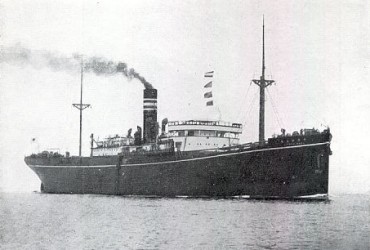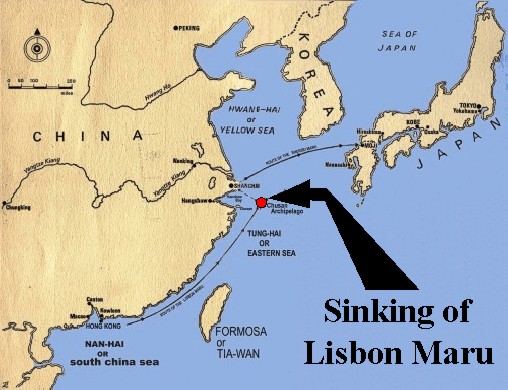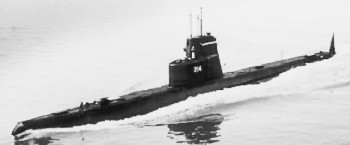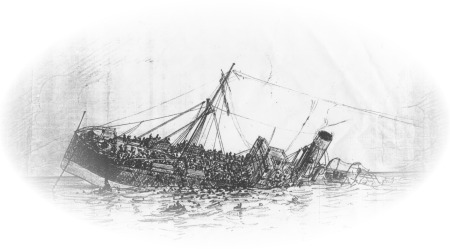|
|
||||||||||||||||
|
|
||||||||||||||||
|
by Bert Garradley |
||||||||||||||||
|
|
||||||||||||||||
|
They were prisoners held by Japan, All stout defenders of Hong Kong; They were there since the war in the East began, Closely knit but a fragile throng.
They went to the land of the Rising Sun, Unfed, bewildered and forlorn, Compelled by the whim of the eager gun To wish that they had never been born!
Once they were armed and neatly furled like flags, Bonded to fight with dignity. But later they cringed tattered in rags, Defenceless from malignity.
Some were the survivers of a ship Taht was sunk by a torpedo crew, Who were all determined to make that trip The last of the Lisbon Maru.
They were battened tight within their holds Despairing, no longer proud, And those that died, though grom separate moulds, Were buried in the same grim shroud.
Those who lived were drawn like floating dross To the crowded surface of the sea, But later others died upon the cross, And the rest survived like me!
Years on in thought I take a longer pause To stem the tears I always shed, When I perceive the frequency of wars, And then relive the pain of dread.
A light descends on those with swords ungirt, Advancing beyond all thought A warning beam of love that eases hurt, And clings as friend help is sought.
My prayers for all concerned who lived and died, For comrades and for foes alike Are offered now, all fully sanctified With love, the Godly essence of my Psych.
Time has dimmed the memories of things that have happened in the last fifty years but the tragedy of the Lisbon Maru, over fifty years ago is etched indelibly in my mind. On leaving Shamshuipo Camp, we boarded a lighter that took us out to the Lisbon Maru, the Captain Shigeru Tsneuda watched the prisoners boarded the freighter. The Navy were ordered into the No 1 forward hold, the Middlesex Regt., Royal Scots and a number of the smaller units into No. 2, the main hold and the Royal Artillery in No. 3 hold abaft the bridge. After much pushing and shoving, it was discovered that No. 1 hold was packed to capacity and about a dozen of us R.N. personel were put into No. 2 hold. All the holds had two levels and each level had been made into two tiers of roughly hewed wood to provide accomodation for the maximum numbers to be transported. Unfortunately when we were ordered below the only room available was on the ballast on the bottom of the ship, on the keel. The ballast consisted of foul smelling hessian sacks filled with sand. They smelt of rotting veg, urine and were dumped in at all angles and many had burst open and one could see the evidence of rat infestation everywhere. The only light was from a single dimly lit light bulb and from the hatch opening above. Getting up to tne upper deck, to go to the toilet, when allowed was a major problem. Avoiding treading on other bodies and negotiating the two narrow companionways or ladders was quite a hazard. Those of us that felt well enough tried to level the sacks of sand out and cover them with our single blanket, but the damp came through almost immediately. The conditions were pretty dismal, in fact grim. There were between eight and nine hundred POW's crammed into the main hold, it was very hot, the air was foul and it was extremely difficult to breathe. There was just enough space for one to sit down comfortably and to lie down was almost impossible without putting ones legs over someones body. On the afternoon of the 26th, a large number of Japanese troops came onboard and occupied the upper part of the hold. They all appeared to be in good spirits, laughing and joking amonst themselves, probably with the thought of going home. At daybreak on the 27th September we weighed anchor and proceeded on the journey that most of us thought would be to Japan. The food on the first four days was guite reasonable compared with what we had been getting in Shamshuipo. There were two meals a day consisting of rice, veg and bully beef. The weather conditions were very good and with only a slight rolling motion, in spite of the cramped quarters, it felt good to be leaving Shamshuipo and back onboard ship again, although some of the men were seasick. On the third day at sea diptheria broke out, the doctors did what they could but had a very limited supply of anti-diptheria serum. Company Sergeant-Major Wigzell of the Royal Signals tried to keep the mens spirits up by getting the fit men to `muck-in´ and help the sick. Shortly afterwards the Sergeant-Major turned to face the sea and died. On the morning of October 1st, about 7am, most people were awake and awaiting the first meal of the day. Suddenly a loud noise, like air rushing from a tyre was heard and one could not tell whether it was inboard or outboard of the ship.
There was speculation in the hold, had we run aground and were the Japs just nervous firing the gun, if it was a torpedo would we be rescued like the Altmark survivors, by the Navy etc. For the rest of the day we heard the Japs moving around then very slowly the ship started to list to port. Towards the evening time, about 7.30pm, we heard a scraping noise and more shouting. The Japanese destroyer `Kure´ had manoeuvred alongside, this was closely followed by the freighter Toyokuni Maru with the orders to take off the Japanese troop. After they bad been evacuated the thick balks of timber were placed across the hatch, the tarpaulins stretched over the top and then wedged down. We were now in total darkness. It was pitch black. Conditions in the hold were getting worse. It was very hot and extremely difficult to breathe. Most of us were wearing just a pair of shorts and a singlet. Some had just the familiar fanduchi or G-string. The moans and groans from sick and dying men filled the air but there was nothing one could do except wait for the Japs to get the disabled ship in tow and try and get it to the shore. By luck I thought I might as well try and lay down to conserve energy, and found that right on the bottom of the ship the air seemed fresher and more tolerable. There was evidently a ventilator on the upper deck that had not been closed and the air shaft went down onto the keel of the ship. We had no idea of time but it must have been in the early hours of the morning after a night that seemed like eternity that a tapping sound was heard. I realised, being a radio operator, that it was morse being tapped by one of the navy boys in the forward hold onto a common connecting pipe. "Have two dead and several dying", was the message I read. Someone in our hold started to reply and then there was a frenzied scream of "stop that tapping" from some demented soul. Up to that time I cannot honestly say that I was a very religious person. As a child I had always been made to walk to the village church twice a day with Sunday school in the afternoon, whether or not it helped me I do not know but I did pray quite earnestly then. The water could be heard swilling around in the next compartment, probably the engine room, and then there were ominous noises as the bulkhead started to give. The list to port had increased, the ship, I estimated was over about 30 degrees and the companionway ladders were almost level. There was some discussion for a few seconds and then some brave soul who had a knife, pushed it up between the hatch boards and cut the tarpaulin. There was a sudden surge up the ladders and the hatch board and covers were pushed aside by weight of numbers. Some of the lads had life jackets but the majority of us had not been able to find one. My feet hardly touched the treads of the ladders and I was out into the fresh air on the upper deck. Some of the half dozen or so guards that had been left onboard fired indescriminately into the hold but they were soon silenced.
I made my way to the starboard side and looked aft. The stern of the ship was under water, some were dashing around and others were ambling around as though it was a holiday cruise. Always abandon ship on the opposite side to which it is sinking is the navy maxim. This, when it is possible is to avoid suction from the sinking vessel. In my estimation it was about twenty five feet down to the water and there were many swimmers, swimming around amongst the flotsam. Timber from the hatch covers was still being thrown over-board and I considered it was too dangerous to dive or jump beacause of the objects and swimmers in the water, so I decided to slide down a rope hanging down the ships' side. The barnacles on the ships side and bottom scratched and cut my legs but he water was marvellous, lovely and cool. My first thoughts on entering the water was to put some distance between myself and the ship and I headed for one of the several ships that were in the vicinity. Many heads were bobbing around in the water and there appeared to be rifle fire from some of the ships, directed at the swimmers. The ships were of various sizes, one was steaming amongst the swimmers intent on running them down. None seemed to be making any attempt to be picking up survivors, so I headed for land which could be seen in the distance. The sea was warm with a long rolling swell and swimming conditions were good. I managed to get hold of a vegetable crate and made good headway towards the shore, greatly assisted by a strong current going inshore. The land turned out to be a group of islands and unfortunately some of the swimmers failed to make land and were swept out to sea by the strong tide flowing between the islands. The islands were very steep and rocky with one small sandy beach, only a few yards wide, which I managed to struggle ashore on. I estimate I had swum about four miles in four hours. There were two sampans in the locality each with a crew of two Chinese men. These picked up many of the survivors and landed on the island, thereby saving many lives. Being extremely dehydrated, my first priority was to find water and scouting around found a trickle of clear water coming down the cliff face and forming a pool on the beach. The water tasted like nectar and all of the hundred or so people that had come ashore had their fill. It was only after climbing the roughly hewn steps to the top of the cliff that we found that the water was coming from a small bamboo shed being used by the local villagers as their toilet. The Chinese community on the island treated us well, fed and clothed us with food and clothes they had to spare. After two days we were picked up by a Jap navy ship and taken into Whampou docks near Shanghai. The Jap navy gave us bully beef, condensed milk and cigarettes but once ashore we were under control of the army, who kept us waiting in near freezing conditions, standing almost naked on the jetty until we boarded the Shinsei Maru for Japan, arriving at Moji on October 10th by Alf Hunt
Sub-Lieutenant Hideo Wada `”We must rescue the British War prisoners, was the foremost thought which leaped to our minds when the ship met the disaster. It was just the hour of the roll-call of prisoners; somewhat taken aback, they were about to stampede. `Don´t worry, Japanese planes and warships will come to your rescue´, we told them. The commotion died down. It was encouraging to note that they had come to have such a trust in the Imperial Forces during a brief War Prisoners camp life. `”All the Japanese, of course, were prepared to share a common fate with the British War Prisoners. That is why we all put on lifebouys (sic) all at one time. The fact that we were able to rescue the majority of the British War prisoners was due to my subordinates and the prisoners obedience to the commander; the prisoners´ reliance on us, and the brave action of the Navy men in the face of the enemy.” “The gunners who were on the ship and who rendered distinguished services included Corporal Ryoyo Moji of Takagicho, Ara-Saka-Ku, Tokyo. In response to volleys of questions posed by press, the actual sinking of the ship was described in the following vein: `”It was about 10.30am. that I happened to discover the sixth torpedo discharged by the submarine rushing towards our vessel. `If it scores a direct hit on our ship it will shatter her to pieces´, we were informed by our squad-leader, Corporal Moji - he then gave us the order to fire at the torpedo which was rushing towards our ship from a distance of 1,200 metres. Surprised beyond words, but faithful to the order, we charged our canon with a shell, aimed at the torpedo and fired. We then looked ahead of us and discovered that we had scored a direct hit. During drills there is a slim chance of hitting such a fast-moving objective, but providence was undoubtedly with us at the time.” `Rushing out of his cabin and in spite of a high fever directing his crew in its operations against the American submarine. and when his ship was going down, remaining on the bridge until the last of the prisoners was transferred to the lifeboats, Shigeru Tsneuda, Captain of the Lisbon Maru, has drawn much praise for his courageous action. Arriving at Moji, Captain Tsneuda said: “I´m sorry I have caused so much trouble”, and gave the following account of the sinking: Captain Shigeru Tsneuda `”I rushed up on the bridge immediately on hearing the warning that we were being attacked by an enemy submarine. As soon as I got to the bridge a torpedo came tearing through the water towards us - I thought that the end had come and closed my eyes. But this first shot was a dud and did not explode. The second torpedo came at us, and then a third - we avoided these by manoeuvring, but a fourth and a fifth cut through the sea towards us. The fourth torpedo, which was shot at us from the front, hit us on the starboard side. I ordered the ship to be turned to starboard in order to avoid the fifth torpedo, but by this time part of the engine-room and starboard stern were shipping water; then the after hatches began to be threatened with water. I decided we could do no more, and sent out requests for help. The first torpedo came at us at 7.10a.m. and it was five minutes later that the fourth torpedo hit us. The fifth torpedo passed us from the starboard to port; as the sixth torpedo was bearing in upon us our courageous gunners hit it at a distance of 1,200 metres. But it was already too late. We tried to prevent the ship from sinking by sealing the boiler-rooms, but because the walls burst soon after we were hit, the ship could no longer move. The water kept rising and finally the ship sank.”´ Hostages of Fortune by Tom Carew
|






